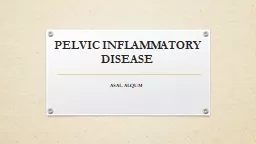

ASAL ALQUM CASE A 19 year old nulligravida presents to the emergency department with bilateral lower abdominal pelvic pain for 24 hours She just finished her menses She is sexually active ID: 910455
Download Presentation The PPT/PDF document "PELVIC INFLAMMATORY DISEASE" is the property of its rightful owner. Permission is granted to download and print the materials on this web site for personal, non-commercial use only, and to display it on your personal computer provided you do not modify the materials and that you retain all copyright notices contained in the materials. By downloading content from our website, you accept the terms of this agreement.
Slide1
PELVIC INFLAMMATORY DISEASE
ASAL ALQUM
Slide2CASE:
A 19 year old nulligravida presents to the emergency department with
bilateral lower abdominal pelvic pain
for 24 hours. She
just finished her menses
. She is
sexually active
but using no contraception. Speculum examination reveals
mucopurulent cervical discharge
. Bimanual pelvic examination shows
bilateral adnexal tenderness
and
cervical motion tenderness
. She is afebrile. Qualitative urinary
b-
hCG
test is negative
. Complete blood cell count shows
WBC 14,000
.
ESR is elevated
.
Slide3What is PID?
PID is a non specific term for a spectrum of upper genital tract conditions ranging from acute bacterial infection to massive adhesions from old inflammatory scarring.
Slide4The most common initial organisms are chlamydia
and
gonorrhea
.
With persistent infection, secondary bacterial invaders include
anaerobes
and
gram-negative
organisms.
Slide5PID is an ascending infection
Cervicitis
Acute salpingo-ophritis
Treatment
No treatment
Heals
without
adhesions
Normal pelvis
Heals
with
adhesions
Chronic PID
Gets worse
TOA
Slide6Slide7Transmission:
Sexual transmission via the vagina &
cervix.
Gynecological surgical
procedures.
Child birth/
Abortion.
A foreign body inside uterus (IUCD). Contamination from other inflamed structures in abdominal cavity (appendix,
gallbladder).Blood-borne transmission (pelvic TB)
Slide8Risk factors:
The most common risk factor is female sexual activity in adolescence, with multiple partners.
Exposure immediately prior to menstruation
.
Relative
ill-health & poor nutritional
status.
Previously
infected tissues (STD/
PID).Frequent vaginal douching.
Slide9Cervicitis
The initial infection starts with invasion of endocervical glands chlamydia and gonorrhea.
Mucopurulent cervical discharge and friable cervix.
No pelvic tenderness. The patient is afebrile.
Positive culture for chlamydia or gonorrhea.
WBCs and ESR are normal.
Management: single dose orally of cefixime and azithromycin.
Slide10Acute Salpingo-Oophritis
Bilateral lower abdominal pain may be variable.
Onset may be gradual to sudden.
Nausea and vomiting may be found if abdominal involvement is present.
Mucopurulent cervical discharge, cervical motion tenderness and bilateral adnexal mass tenderness.
Fever, tachycardia, abdominal tenderness, peritoneal signs and guarding may be found depending on the extent of infection progression.
Slide11Acute salpingo-ophritis
CLINICAL DIAGNOSIS.
Minimal criteria:
1)
Pain
: pelvic or lower abdominal.
2)
Tenderness: cervix, uterus, adnexa.
3) Sexually active woman. 4) No other identified cause.
Slide12Acute salpingo-ophritis
Supportive
crieteria
:
Fever.
Mucopus
: cervical or vaginal.
Leukocytes: vaginal fluid.
Elevated WBC or ESR or CRP.
Positive GC or Chlamydia testing.
Slide13Acute salpingo-ophritis
Most specific criteria for diagnosis:
Endometrial biopsy showing endometritis.
Vaginal sono or MRI imaging showing abnormal adnexa.
Laparoscopic abnormalities consistent with PID.
Slide14Management
Inpatient criteria:
High fever.
Nausea and vomiting.
Failed outpatient therapy.
Severe pain
Unsure diagnosis
TOA
Antibiotics
:
Cefotetan
2g IV q 12handDoxycycline 100mg IV q 12h
Slide15Management
Outpatient criteria:
Absence of inpatient criteria.
Ceftraxone
250mg IM x1
Doxycycline
100mg bid x 14d
With or without
Metronidazole
Slide16Differential diagnosis
Adnexal torsion
Ectopic pregnancy
Endometriosis
Appendicitis
Diverticulitis
Crohns
disease
Slide17Tubo-Ovarian Abcess
Is the accumulation of pus in the adnexa forming an inflammatory mass involving the oviducts, ovaries, uterus or omentum.
T
he patient will look septic
Lowe abdominal pain is severe
Often there is severe back pain, rectal pain and pain with bowel movements.
Nausea and vomiting are present.
High fever
Slide18Tubo-Ovarian Abcess
Tachycardia
May be in septic shock with hypotension
Abdominal exam: peritoneal signs, guarding and rigidity
Bilateral adnexal masses may be palpable.
Investigative findings: WBCs and ESR are markedly elevated, positive cervical culture for chlamydia or gonorrhea, blood cultures may be positive for gram-negative bacteria and anaerobic organisms.
Sono or CT will show bilateral complex pelvic masses.
Slide19Tubo-Ovarian Abcess
Management:
Inpatient IV
gentamycin
and
clindamycin
If
no response
or there is
rupture
of the abcess exposing free pus into the peritoneal cavity then an exploratory laparotomy with possible TAH and BSO
or percutaneous drainage may be required.
Slide20Tubo-Ovarian Abcess
Differential diagnosis:
Septic abortion
Diverticular or appendicular
abcess
Adnexal torsion
Slide21Chronic PID
Chronic bilateral lower abdominal pain and tenderness
Cervical motion tenderness
History of
infertility, dyspareunia, ectopic pregnancy
Nausea and vomiting are absent
Normal WBC and ESR
No
mucopus
No fever
Slide22Chronic PID
Diagnosis:
laparoscopic
visualization of diffuse pelvic adhesions
Mild analgesics, lysis, severe unremitting pain may require TAH-BSO.